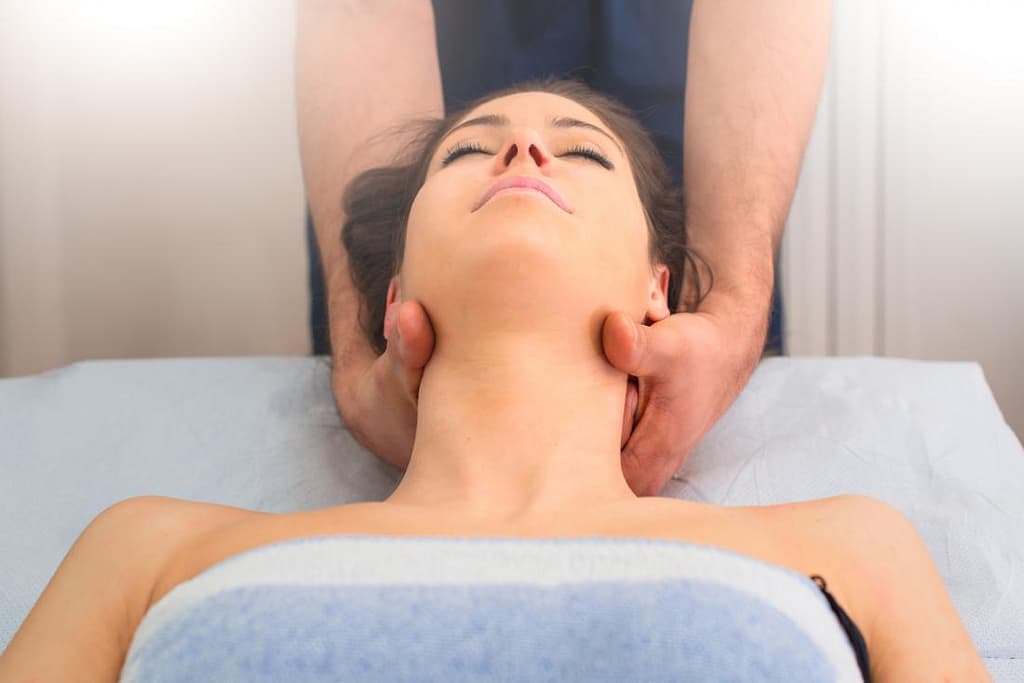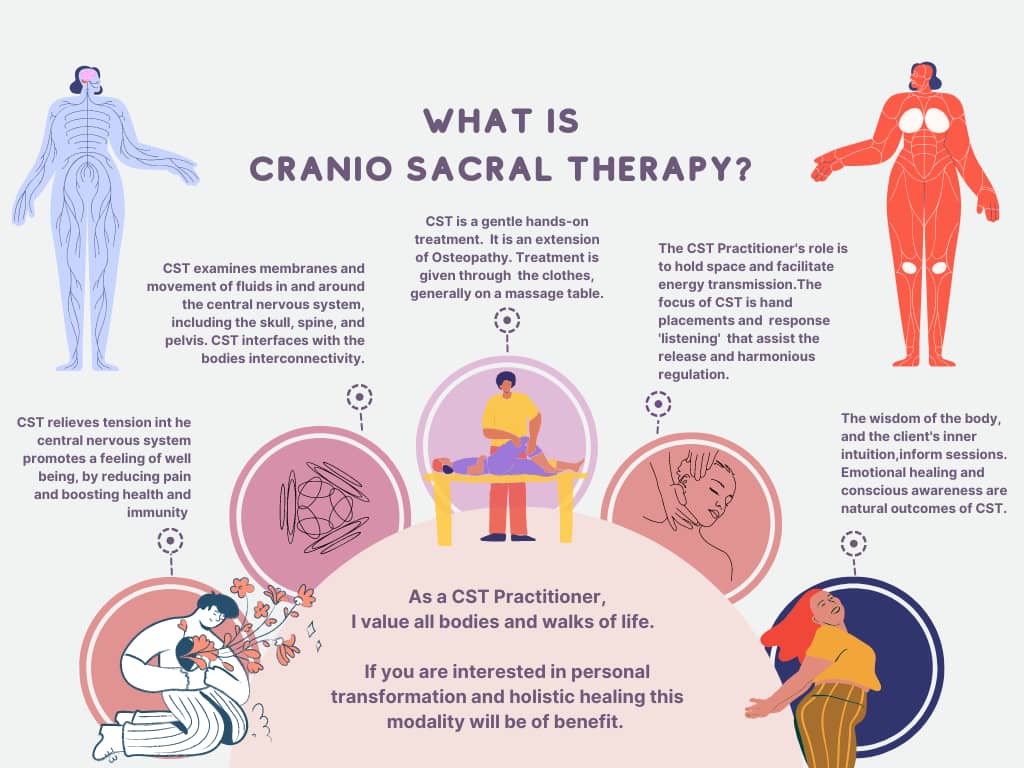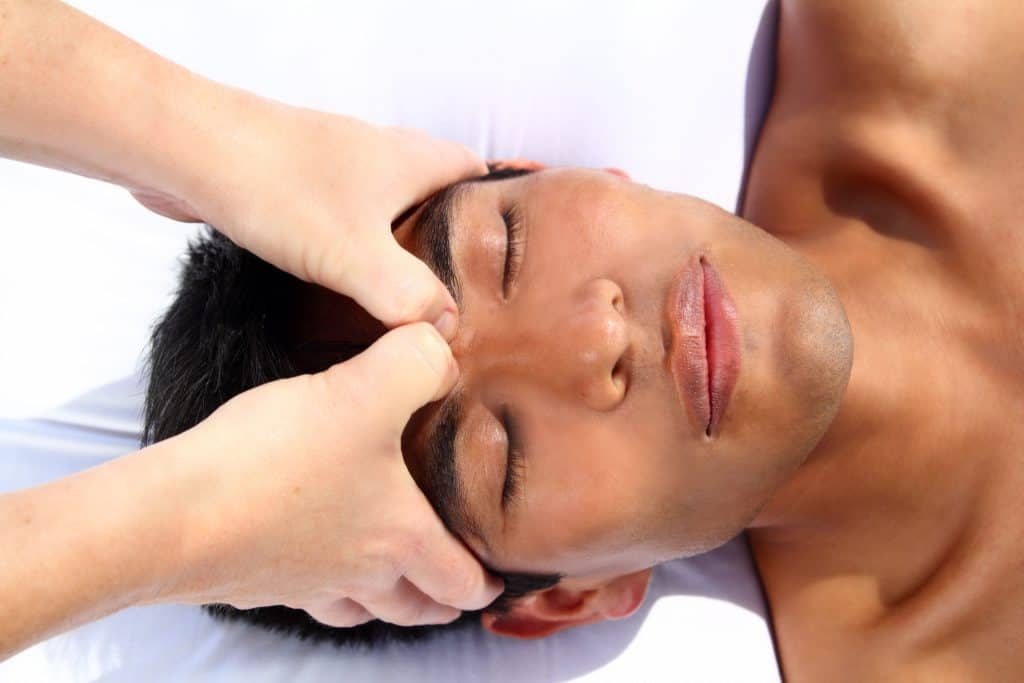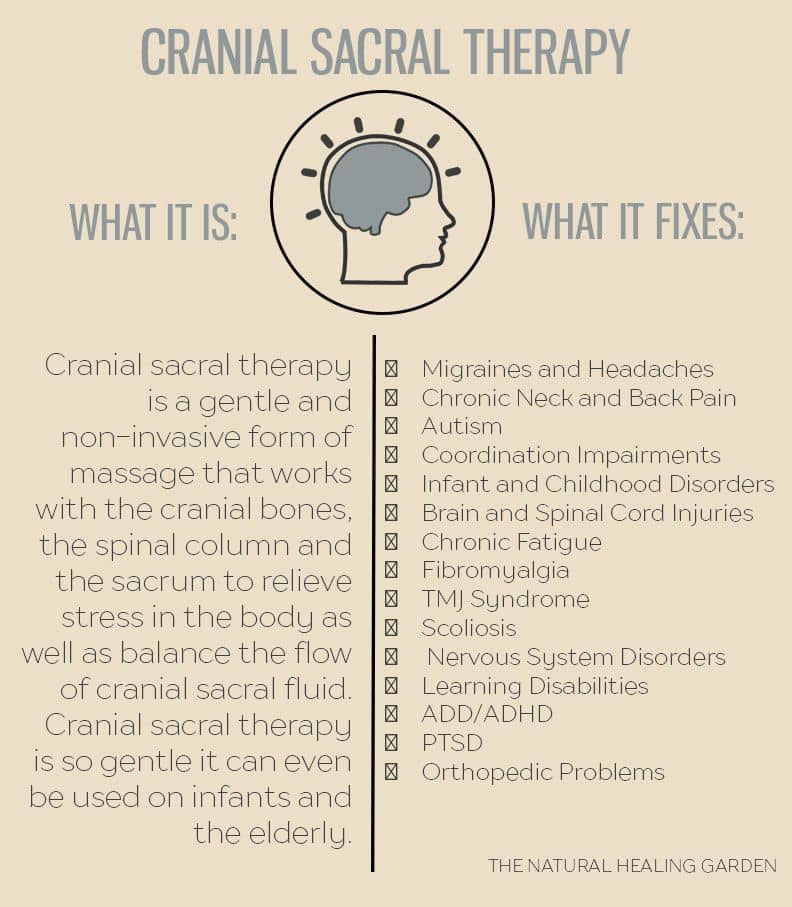
Cranial Sacral Therapy (CST), is a subtle but effective bodywork that has gained popularity in recent times. This holistic approach to healing focuses on the craniosacral system which includes membranes and fluid enveloping the brain and spinal cord. The aim of manipulating this system is to ensure general well-being.
Understanding Cranial Sacral Therapy: A Full Review
Craniosacral therapy involves a soft, hands-on procedure to manipulate the craniosacral system, which is made up of the protective membranes and fluids of the brain and spinal cord. The originators, however, developed CST as a gentle, light-touch method to support the natural self-correcting capabilities of the body in ways quite different from those of conventional therapies.
Core Elements of CST
Light Touch: In touch, a practitioner applies light pressure on a place to begin a release in this system.
- Self-Healing Focus: CST enhances the body’s self-healing capability to further total health. Whole-Body Integration: Imbalances in the body, emotions, and energy are dealt with using CST.
- Non-invasive Approach: The gentle techniques make it quite suitable for all age groups, from infants to elderly people.
- Holistic in Nature: The nature of CST itself is quite different from most traditional medical treatments.
The Historical Roots and Development of Cranial Sacral Therapy
The roots of Cranial Sacral Therapy can be traced back to the early 20th century when osteopathic physician William Sutherland made a groundbreaking discovery. Sutherland observed that the cranial bones were designed for slight movement, contradicting the widely held notion that they were fused and immobile. This observation led him to develop cranial osteopathy, which was later expanded upon to form modern-day Cranial Sacral Therapy.
Dr. John Upledger, an osteopathic physician and researcher who built on Sutherland’s work, improved it during the 1970s. Through his research, he gathered scientific proof of the existence of the craniosacral system with its rhythmic motion. These findings laid down the foundation for what we now refer to as Cranial Sacral Therapy.
This table provides a structured overview of the techniques commonly used in Cranial Sacral Therapy.
Cranial Sacral Therapy Principles And Techniques
A few key principles form the foundation of Cranial Sacral Therapy:
- The ability of the body to heal itself
- Vitality preservation via craniosacral rhythm
- All systems in the body are linked together
- The power of gentle touch facilitates healing.
In a typical CST session, a practitioner uses light touch– usually no more than the pressure of a nickel coin – to evaluate restrictions present within the craniosacral system while offering therapy. Such treatments can be done on various parts including head, spine, sacrum, etc.

Fundamental Concepts and Techniques of Craniosacral Therapy
CST is founded on the principle that the craniosacral system is one of the most important systems in the body. Thus, it points to some key principles and techniques for conducting the therapy, such as:
- The craniosacral rhythm: Practitioners palpate the small movements of the cerebrospinal fluid to detect restrictions or imbalances.
- Light Touch Light: Gentle touch greater than nickel weight is continuously used while manipulating the cranial bones and tissues.
- Unwinding of Tensions: CST aims to release stored tension in the body’s connective tissues, thereby improving function and relieving pain.
- Whole-Body Healing: CST treats the body as an integrated system, with treatment targeted at general health improvement, facilitating the body’s self-healing functions.

Exploring the Healing Benefits of Cranial Sacral Therapy
Cranial Sacral Therapy, or CST, covers different dimensions of healing benefits: physical, emotional, and mental. Improvement from practitioners and patients alike:
- Physical Relief: The technique releases tension in the craniosacral system, relieving chronic pain, migraines, and neck and back problems.
- Emotional Balance: The light contact enables the release of trauma, allowing the individual to be in a place of calm that reduces anxiety and depression.
- Quality Sleep: Most patients reported improved sleeping patterns due to the improvement in the functioning of the nervous system facilitated by CST.
- Improved Concentration Ability: CST works in facilitating focus, concentration ability, and diminishing mental fogginess.
- Better Wellbeing: Promoting self-healing in this body, physical and emotional health are enhanced by the CST.
Who Can Benefit from Cranial Sacral Therapy?
CST is effective for all types of individuals from varied walks of life and can cure them from physical, emotional, and mental health issues. The category of patients it can cure includes:
- People Suffering from Chronic Pain: CST helps in alleviating pain related to migraines, lower back pain, and joint pain.
- Those with Stress and Anxiety: Gentle manipulations encourage relaxation and the release of bottled-up emotions, which help to decrease anxiety and tension.
- Children and Infants: Because of the gentleness of this modality, CST is non-invasive for newborns suffering from colic, sleep issues, or developmental delays.
- Individuals with Trauma: CST helps clear patterns of emotional or physical traumas which may have been stored in the body.
- Elderly: The gentleness supports mobility while reducing pain and promoting relaxation amongst seniors.
CST addresses an array of needs through its approach to holistic healing.
Scientific Insights: What Does the Research Say About Cranial Sacral Therapy?
Research into CST is still in its infancy, though various studies highlight its uses. Although more trials of a more robust nature need to be done, what can be determined from the available data is:
- Pain: There is evidence that it may reduce chronic pain disorders. Specifically, migraines and lower back pains.
- Reduce Stress: There is evidence showing a reduction of cortisol levels following CST; hence, the reduction of stress and anxiety.
- Improved mobility: Some studies show that CST can offer a better range of motion and flexibility in older patients.
- Neurological Support: Some early beginnings are promising in the management of neurological disorders, like multiple sclerosis and autism.
Though more studies are needed, it has a growing interest in alternative therapy as the procedure of CST is non-invasive and its benefits have been documented.

Step-by-Step Guide: What Happens during a Cranial Sacral Therapy
The session of cranial sacral therapy lasts about 45-60 minutes. This is how a session goes:
- First Evaluation: The practitioner will carry out a thorough history taking and discussion of main complaints of the patient as well as the treatment objectives.
- Preparation: Although the patient remains fully clothed, he or she will be lying on a table. Alternatively, the position of the patient may be over the arms, forehead or back depending on the comfort.
- Treatment: The therapist will put the hands on specific points on the body and try to assess the mobility of the craniosacral system among others. Patients frequently report feelings of warmth, tingling sensations, or even deep relaxation.
- Question and Answers: After the session, the caregiver may talk to the patient and approve some self-care measures.
Most of the persons visiting CST sitting takers feel improved afterward. It is typical for one to feel worn out or even experience mild soreness as they tend to learn how to accommodate their bodies during the period.
Integrating Cranial Sacral Therapy with Conventional and Complementary Therapies
One should note that most Cranial Sacral Therapy is well accompanied by other healing methods. These are some typical mixtures:
- Massage Therapy: Deeper structural imbalances can be addressed by CST, thereby complementing massage effects.
- Chiropractic Care: CST techniques can supplement spinal manipulations when applied together with chiropractic care.
- Physical Therapy: Chronic pain and movement restrictions can both be handled within a standard physical therapy using CST alongside traditional physical therapy practices.
- Psychotherapy: Emotional release facilitation resulting from relaxation caused by CST is compatible with talk therapy.
- Acupuncture: Body energy systems balancing is equally aimed at by both CST and acupuncture thus they work best while used together simultaneously.
- Yoga and Meditation: This practice’s focus on mindfulness and body awareness is consistent with that of CST.
With the aim of a more holistic approach to health and healing, practitioners usually combine CST with other modalities.

How to Find a Qualified Cranial Sacral Therapist?
Your attention to finding a qualified Cranial Sacral Therapist is needed. First, ensure they have certifications from recognized institutions like the Upledger Institute and the Biodynamic Craniosacral Therapy Association.
What you will want to see is the experience; hence, ask about years of practice and what conditions they specialize in. Check the success rate by looking for reviews or testimonials from past clients. This being a treatment that uses gentle, hands-on techniques, it is really necessary that the therapist makes the setting comfortable and safe for the individual.
For instance, one should not fiddle over requesting an initial consultation, as this way it will make a difference in the kind of approach one needs. A good therapist will also put efforts into clear communication with regard to what one can expect, explaining in a manner that the client can understand and setting realistic expectations.
Finally, trust your instincts-find a therapist you are at ease with because the therapeutic relationship is going to be the most important part of your treatment. This is going to ensure the process that you get provided with safe and effective care by a competent professional in cranial sacral therapy.
Potential Side Effects and Precautions of Cranial Sacral Therapy
Cranial Sacral Therapy is generally a non-invasive and harmless therapy, one can be quite aware of its risks and side effects. A few clients might experience slight discomfort or soreness after having a session since the body adjusts itself to the gentle manipulation affecting the cranial bones and soft tissues.
This is contraindicated for patients with fresh head trauma, aneurysms, severe osteoporosis, and other conditions that may get exacerbated by the treatment. Of course, it is prudent to consult with a physician before commencing CST, especially if one has chronic conditions or medical concerns. CST is definitely useful to many people, but again, with proper precautions and with the proper therapist, the risks can be minimal and treatment safely made.
Understanding the Financial Investment in Cranial Sacral Therapy
CST is both a time and financial investment. Costs per session typically range between $70 and $150, depending on location and the therapist’s experience. Since CST usually deals with conditions that are ongoing in nature, it usually takes multiple sessions to have really long-lasting effects; this does add up over time.
Insurance does not always cover CST, so this is best checked with your provider. Although this might be a lot up-front, many find pain relief, improvement in mobility, and reduced stress to be long-term benefits well worth their investment in health and wellbeing.
How to Become a Practitioner of Cranial Sacral Therapy?
To become a practitioner of CST, one must undergo specific training from recognized accredited institutions such as the Upledger Institute. Both anatomy, physiology, and hands-on techniques are some of the covered courses.
Most of the courses provide various levels of certification whereby a practitioner could increase his competence in a progressive way. This is followed by professional certification through a recognized body like the Biodynamic Craniosacral Therapy Association.
Such skills are only developed through hands-on experience, such as through internships or mentorship. On the other hand, most CST practitioners have a background in general health, massage therapy, or bodywork and, therefore, can have something to stand on regarding how to apply the techniques learned in CST.
How to Get Started with Cranial Sacral Therapy?
Any treatment first requires research to find a qualified therapist certified by reputable institutions such as the Upledger Institute in Cranial Sacral Therapy. An introductory appointment may be scheduled wherein you outline your health issues your expectations from the treatment, and the successful results one may get from treating their condition with CST.
During the first session, the patient is usually exposed to slight pressure as the therapist examines the cranial rhythm, which the therapist would work to normalize. Be open to more than one session; sometimes the treatment even if complete still needs some stabilization to last over time. Always check with the doctor if this type of treatment is acceptable with his or her recommendations.
Conclusion
Cranial Sacral Therapy (CST) is a safe form of therapy that seeks improvement of a client’s health in the physical and psychological realms. While members of the health profession continue to engage in the scientific debate, a large number of the population attest that their issues involving the cervical spine and related symptoms are solved through CST. With the practice of Cranial Sacral Therapy, which is part of the Wellness path, as with all other supplementary therapies, it is necessary to be guided by healthcare specialists and undergo treatment with professionals.

